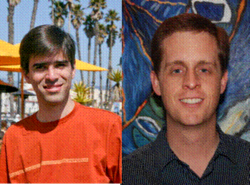
Assistant Professors Rodrigo Fonseca and Erik Sudderth
The Department is pleased to announce the addition of two new faculty members, Rodrigo Fonseca and Erik Sudderth, who will both start at Brown in the fall of 2009. Rodrigo will join the Department after doing postdoctoral work at Yahoo! Research and receiving his Ph.D. from the Computer Science Division of the University of California at Berkeley. His interests lie at the intersection of networking, operating systems and distributed systems. Erik will come to Brown after serving as a postdoctoral scholar at the University of California at Berkeley. He received his Ph.D. from MIT and his interests include statistical machine learning and computer vision.
With the addition of Erik and Rodrigo, the Department is expected to reach a record number of 26 tenured and tenure-track faculty on its thirtieth anniversary next fall. Our two new faculty members will help serving our growing population of graduate and undergraduate students. “Both Rodrigo and Erik are exceptionally bright, talented young scholars and we are thrilled to have them join our department,” said Chair Roberto Tamassia. “We are all looking forward to welcoming them to Brown next fall.”
Rodrigo Fonseca
Rodrigo received his M.S. and B.S. in Computer Science from the Universidade Federal de Minas Gerais in Brazil, and expects to complete his Ph.D. in 2008 from the Computer Science Division of the University of California at Berkeley. In 2004, he was the recipient of a UC Berkeley/United Nations Industrial Development Organization Fellowship, and in that year he also served as a research intern at Hewlett-Packard Labs in Palo Alto, working on wide-area Internet latency and bandwidth measurement. He has been invited to give a number of talks, including "4-Bit Link Estimation" at Stanford University and "X-Trace: A Pervasive Network Tracing Framework" at Cisco, Google and Nortel. Rodrigo’s current research deals with providing visibility into the execution of widely distributed applications with heterogeneous components, with the purpose of improving performance and troubleshooting. He is also working on projects related to wireless sensor networks and information forensics.
Broadly, Rodrigo is interested in understanding the behavior of systems with many components for enabling new functionality, and making sure they work as they should. He is also interested in the impact that telecommunications and computing may have on development. "I am very excited to be joining the CS department at Brown,” Rodrigo said. “The University has the right combination of a friendly and productive environment, excellent faculty and students. I am eager to contribute to teaching and research, and to foster productive collaborations."
Erik Sudderth
Erik received his B.S. from the University of California, San Diego and his Sc.M. and Ph.D. from MIT, and comes to Brown after serving as a postdoctoral scholar at the University of California at Berkeley. In 2004-05, he was the recipient of an Intel Foundation Doctoral Fellowship. He served as a research intern at Mitsubishi Electric Research Laboratories, using graphical models to design and analyze error correcting code. Erik has been invited to give a number of talks, including “Learning Object Appearance Models via Transformed Dirichlet Processes” at Stanford University and at Google, and “Visual Tracking using Nonparametric Belief Propagation” at the Institut National de Recherche en Informatique et en Automatique in Rennes, France, and also at MIT and Intel Research. His research explores computer vision systems which detect, recognize, and track objects in complex natural scenes.
Erik’s current focus deals with developing and applying statistical tools including: probabilistic graphical models, nonparametric Bayesian statistical methods, object recognition and scene understanding, and image processing.
According to Erik, “The Brown CS department has a tradition of interdisciplinary research, which I find very appealing. My own work in statistical machine learning and computer vision has interesting connections to ongoing research in the departments of cognitive & linguistic science, neuroscience, engineering, and applied mathematics. Moreover, the CS department's small size and friendly atmosphere create great opportunities for internal collaboration. I look forward to exploring exciting new application domains for statistical methods.”
